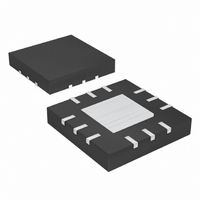MAX1077ETC+ Maxim Integrated Products, MAX1077ETC+ Datasheet - Page 16

MAX1077ETC+
Manufacturer Part Number
MAX1077ETC+
Description
IC ADC 10BIT 1.5MSPS 12-TQFN
Manufacturer
Maxim Integrated Products
Datasheet
1.MAX1077ETC.pdf
(18 pages)
Specifications of MAX1077ETC+
Number Of Bits
10
Sampling Rate (per Second)
1.5M
Data Interface
MICROWIRE™, QSPI™, Serial, SPI™
Number Of Converters
1
Power Dissipation (max)
22mW
Voltage Supply Source
Analog and Digital
Operating Temperature
-40°C ~ 85°C
Mounting Type
Surface Mount
Package / Case
12-WQFN Exposed Pad
Number Of Adc Inputs
1
Architecture
SAR
Conversion Rate
1500 KSPs
Resolution
10 bit
Input Type
Differential
Interface Type
3-Wire (SPI, QSPI, MICROWIRE)
Voltage Reference
Internal 2.048 V or External
Supply Voltage (max)
3.6 V
Supply Voltage (min)
2.7 V
Maximum Power Dissipation
1349 mW
Maximum Operating Temperature
+ 85 C
Mounting Style
SMD/SMT
Minimum Operating Temperature
- 40 C
Lead Free Status / RoHS Status
Lead free / RoHS Compliant
Aperture delay (t
falling edge of CNVST and the instant when an actual
sample is taken.
For a waveform perfectly reconstructed from digital sam-
ples, signal-to-noise ratio (SNR) is the ratio of full-scale
analog input (RMS value) to the RMS quantization error
(residual error). The theoretical minimum analog-to-digital
noise is caused by quantization error, and results directly
from the ADC’s resolution (N bits):
In reality, there are other noise sources besides quantiza-
tion noise, including thermal noise, reference noise, clock
jitter, etc. Therefore, SNR is computed by taking the ratio
of the RMS signal to the RMS noise, which includes all
spectral components minus the fundamental, the first five
harmonics, and the DC offset.
Signal-to-noise plus distortion (SINAD) is the ratio of the
fundamental input frequency’s RMS amplitude to the
RMS equivalent of all other ADC output signals:
Effective number of bits (ENOB) indicates the global
accuracy of an ADC at a specific input frequency and
sampling rate. An ideal ADC’s error consists of quantiza-
tion noise only. With an input range equal to the full-scale
range of the ADC, calculate the ENOB as follows:
1.5Msps, Single-Supply, Low-Power, True-
Differential, 10-Bit ADCs with Internal Reference
Figure 19. Interfacing to the ADSP21_ _ _
16
SINAD(dB) = 20 x log (Signal
______________________________________________________________________________________
MAX1077
MAX1079
ENOB
SNR = (6.02 x N + 1.76)dB
CNVST
DOUT
SCLK
Signal-to-Noise Plus Distortion
AD
V
L
) is the time defined between the
=
Effective Number of Bits
(
SINAD
Signal-to-Noise Ratio
6 02
.
− 1 76
RMS
VDDINT
TCLK
RCLK
TFS
RFS
DR
Aperture Delay
.
/ Noise
ADSP21_ _ _
)
RMS
)
Total harmonic distortion (THD) is the ratio of the RMS
sum of the first five harmonics of the input signal to the
fundamental itself. This is expressed as:
where V
V
harmonics.
Spurious-free dynamic range (SFDR) is the ratio of the
RMS amplitude of the fundamental (maximum signal
component) to the RMS value of the next-largest distor-
tion component.
Full-power bandwidth is the frequency at which the input
signal amplitude attenuates by 3dB for a full-scale input.
Figure 20. Power-Supply Grounding Condition
5
are the amplitudes of the 2nd- through 5th-order
V
V
DD
DD
1
THD
is the fundamental amplitude, and V
0.1µF
10µF
=
MAX1077
MAX1079
20
Spurious-Free Dynamic Range
GND RGND
x
log
GND
Total Harmonic Distortion
SUPPLIES
0.1µF
10µF
Full-Power Bandwidth
V
2
2
+
V
V
L
3
2
V
1
+
V
4
2
+
CIRCUITRY
V
DGND
DIGITAL
5
2
2
through
V
V
L
L









